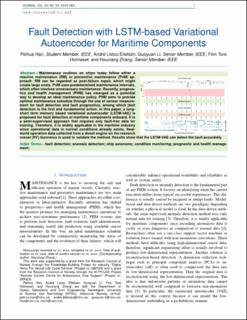| dc.contributor.author | Han, Peihua | |
| dc.contributor.author | Ellefsen, Andre | |
| dc.contributor.author | Li, Guoyuan | |
| dc.contributor.author | Holmeset, Finn Tore | |
| dc.contributor.author | Zhang, Houxiang | |
| dc.date.accessioned | 2022-04-26T12:33:00Z | |
| dc.date.available | 2022-04-26T12:33:00Z | |
| dc.date.created | 2021-08-18T12:29:42Z | |
| dc.date.issued | 2021 | |
| dc.identifier.citation | IEEE Sensors Journal. 2021, 21 (19), 21903-21912. | en_US |
| dc.identifier.issn | 1530-437X | |
| dc.identifier.uri | https://hdl.handle.net/11250/2992857 | |
| dc.description.abstract | Maintenance routines on ships today follow either a reactive maintenance (RM) or preventive maintenance (PvM) approach. RM can be regarded as post-failure repair, which might create large costs. PvM uses predetermined maintenance intervals, which often involves unnecessary maintenance. Recently, prognostics and health management (PHM) has emerged as a potential way to develop an ideal maintenance policy. PHM aims to provide optimal maintenance schedule through the use of sensor measurement for fault detection and fault prognostics, among which fault detection is the first and fundamental action. In this paper, a long-short term memory based variational autoencoder (LSTM-VAE) is proposed for fault detection of maritime components onboard. It is a semi-supervised approach that requires only fault-free data for training. Therefore, it is widely applicable in the maritime industry since operational data in normal conditions already exists. Real-world operation data collected from a diesel engine on the research vessel (RV) Gunnerus is used to validate the method. Results show that the LSTM-VAE can detect the fault accurately. | en_US |
| dc.language.iso | eng | en_US |
| dc.publisher | IEEE | en_US |
| dc.title | Fault Detection with LSTM-Based Variational Autoencoder for Maritime Components | en_US |
| dc.type | Journal article | en_US |
| dc.type | Peer reviewed | en_US |
| dc.description.version | acceptedVersion | en_US |
| dc.rights.holder | © 2021 IEEE. Personal use of this material is permitted. Permission from IEEE must be obtained for all other uses, in any current or future media, including reprinting/republishing this material for advertising or promotional purposes, creating new collective works, for resale or redistribution to servers or lists, or reuse of any copyrighted component of this work in other works. | en_US |
| dc.source.pagenumber | 21903-21912 | en_US |
| dc.source.volume | 21 | en_US |
| dc.source.journal | IEEE Sensors Journal | en_US |
| dc.source.issue | 19 | en_US |
| dc.identifier.doi | 10.1109/JSEN.2021.3105226 | |
| dc.identifier.cristin | 1926944 | |
| cristin.ispublished | true | |
| cristin.fulltext | preprint | |
| cristin.fulltext | preprint | |
| cristin.qualitycode | 2 | |
